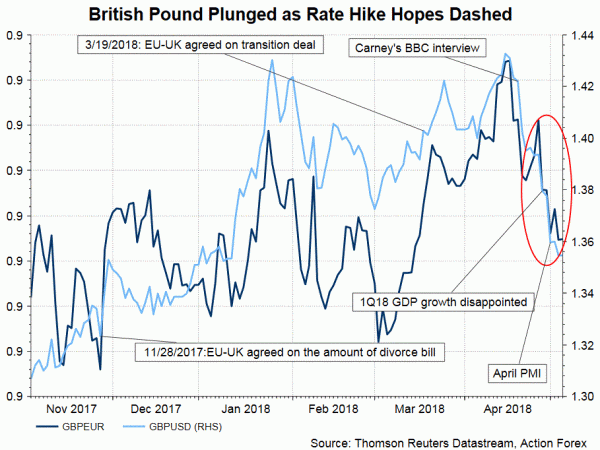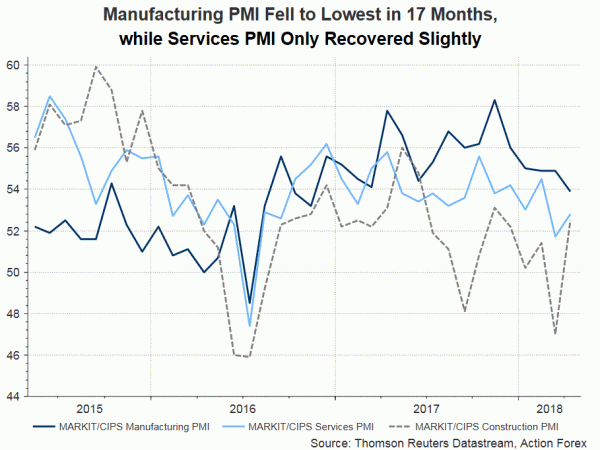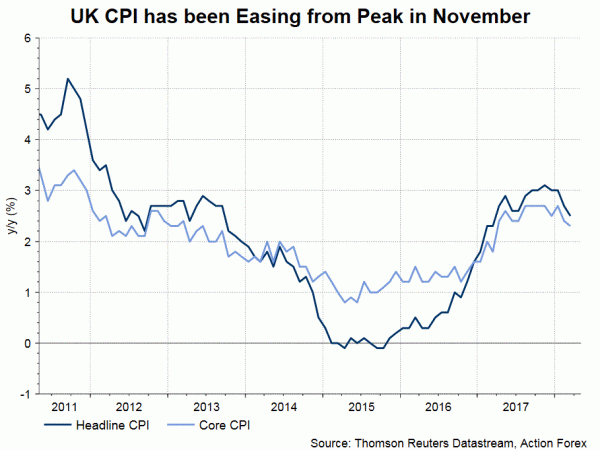BOE is almost certain to keep the Bank rate unchanged at 0.5% in the May meeting. Weakness in PMI data released last week aggravated concerns that recent the moderation in economic activities might persist. Doubts have arisen that whether the slowdown in 1Q18 is only driven by transitory factors or indeed by some underlying reasons. While the market continues to expect the BOE to maintain the so-called “hawkish hold” in May – members voting 7-2 to leave rate at 0.5% and maintaining the rhetoric that “an ongoing tightening of monetary policy over the forecast period would be appropriate”, we actually believe it is possible for the central bank to turn more dovish, e.g. revising lower GDP growth and inflation forecasts. The market has now priced in only 50/50 chance of an August hike. Indeed, the possibility of an unchanged monetary policy throughout the year has increased.

Released last week, Markit’s PMI report indicated weakness in UK economic activities might extend from the first quarter to the second quarter. Services PMI recovered slightly, by +1.1 points to 52.8 in April. Yet, this missed consensus of 53.5. The improvement from March’s 20-month low of 51.7 was just mild and marked the second weakest rate of growth since September 2016. Manufacturing PMI dropped -1.2 points to a 17-month low of 53.9, missing expectations of 54.8. The sub-indices of output, new orders and employment also displayed slowdown in growth. As Markit noted “while adverse weather was partly to blame in February and March, there are no excuses for April’s disappointing performance, making the chances of a near term hike in interest rates by the Bank of England look increasingly remote”. It added that “the sector is unlikely to see any improvement on the near-stagnant performance signaled by the opening quarter’s GDP numbers” and “the trend in manufacturing production is likely to remain subdued”. Construction PMI improved to 52.5 from 47. This beat consensus of 50.5. While the rebound appeared strong, it was after the weather-related disruption in March. Underlying demand across the construction sector remained subdued, with total new work rising only marginally in April.

In the previous report (https://www.actionforex.com/action-insight/special-topics/90825-brexit-uncertainty-remains-key-determinant-of-boes-rate-hike-path/), we suggested that the government, and probably BOE officials, might have seen the disappointing GDP growth in 1Q18 as driven by adverse weather, temporary factor that should not continue in coming months. However, the weakness in PMI reports are probably first hints that the slowdown might have persisted in the second quarter. That is something worth monitoring.
The ease in inflation has also made a rate hike less imminent. Back in November, BOE’s rate hike was driven by the fact that inflation has overshot +3%, significantly higher than the +3% target, for months. Governor Mark Carney noted at the November meeting that inflation is “unlikely to return to the 2% target” without a rate hike.

Back then, the governor had since September prepared the market for the November rate hike. In February this year, Carney hinted at earlier and larger rate increases with the meeting minutes indicating that “monetary policy would need to be tightened somewhat earlier and by a somewhat greater extent over the forecast period than anticipated at the time of the November report”. It was interpreted as a hint for the May hike. However, the central bank has changed course over the month. Carney noticeable turned more dovish at his BBC interview on April 19. While affirming a rate hike is “likely” this year, he emphasized that any increase would be “gradual”. The Governor attempted to downplay the chance of a May rate hike. As he noted, “I am sure there will be some differences of view but it is a view we will take in early May, conscious that there are other meetings over the course of this year”. He suggested that there was a lot of data to consider before the decision in May, adding that “we have had some mixed data… On the softer side some of the business surveys have come off. Retail sales have been a bit softer – we are all aware of the squeeze that is going on in the high street”. The language, together with recent soft economic data, suggest that the chance for a May rate hike in May is remote.













